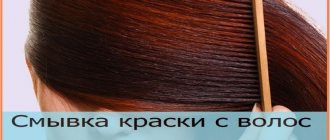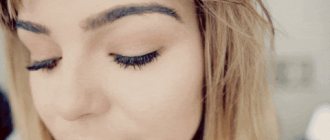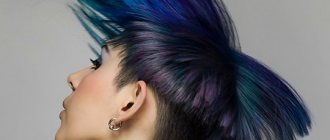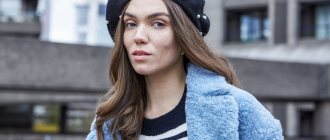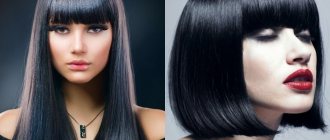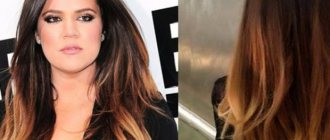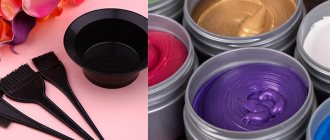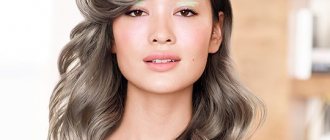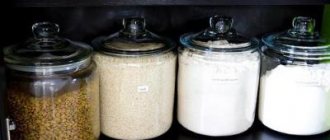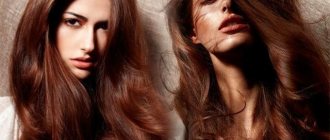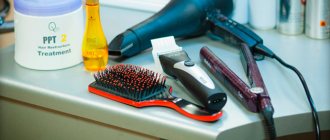Many representatives of the fairer sex use henna masks to strengthen their hair, change its color and improve its condition. However, this product has its drawbacks, which all girls who use henna to care for their curls should know. We will talk about the positive and negative effects of this product on hair in our article today.
What is henna made from?
A popular natural dye is a loose powder made from the dried leaves of a shrub called Lawsonia nonthorny. For hair coloring, as a rule, the lower leaves of the plant are used, which are subjected to rougher processing. Foliage from the upper branches is most often used for applying body designs, which are called mehendi.
A distinctive property of this dye is the ability to give hair a rich red or copper-brown color, depending on the natural shade of the hair. However, today manufacturers of natural dyes are finding new ways to diversify the color palette and chemical composition of henna in order to enhance its benefits for hair and make it even more attractive to consumers.
However, even without these additions, henna has a lot of useful properties that set it apart from other means for changing hair pigment.
Types of henna
There are several types of henna for hair:
- ordinary, or red;
- colorless;
- black henna, or basma.
Henna in the traditional sense is made from lawsonia, while basma is obtained from the leaves of indigofera tinctifera.
Colorless henna is an extract of the same lavsonia, which is processed in such a way that all pigment is removed from it, so this substance has almost no effect on hair color. However, its beneficial properties will be appreciated by those who want to prolong the health and beauty of their hair.
Important! Along with colorless henna for hair, you can find its white variation on sale. The second is an artificially manufactured preparation akin to other chemical paints, which in terms of benefits is incomparable to the first.
How is henna used for hair?
The main use of henna for hair is to color it. Thanks to the fixative of natural origin, the color range of paints can vary: black, dark brown, chestnut, burgundy. Because of this, you need to carefully follow the instructions when coloring your hair. There is a possibility of receiving a color that you do not expect. Moreover, even if you follow the instructions, you may get a surprise, because... Manufacturers sometimes cheat and some batches may contain more henna than impurities and vice versa. And of course, your own hair color affects the final result.
Henna is also used to treat hair. To do this, masks are made that are applied to the hair roots or to the hair itself. Remember that colorless henna does not exist. Olive oil is added to the mask. Such masks are usually very nourishing, but they are not recommended for frequent use. A couple of times a month will be enough. By the way, if you mix this dye with the essential oils of some plants and then hold your hair under the sun, you can lighten the black color to a chestnut shade. Henna can be mixed with basma for a darker and deeper color.
Useful properties of henna
Lawsonia powder has proven its benefits for thousands of years. It has been used in India, Pakistan, and North African countries to treat various skin conditions, including dandruff, boils, and acne. With its help, stomatitis and trophic ulcers were eliminated. The bactericidal properties of the dye relieved swelling and inflammation.
But the medicinal properties of henna have the greatest benefit on the condition of the hair. In addition to the fact that this unique natural paint provides them with long-lasting color, it also:
- has a beneficial effect on the scalp;
- helps strengthen hair follicles, preventing hair loss;
- has the useful property of regulating the production of sebum, thanks to the tannins in its composition;
- restores the structure of the hair shaft, preventing it from splitting;
- gives shine to curls and makes them more manageable.
Henna for hair: benefits
Today, in order to be stylish, it is enough to purchase a stylish package of selected henna. This paint contains no chemicals or other impurities, and is brought directly from distant India. That's why quality is guaranteed. The composition of this natural paint exceeds all expectations, and the color palette is replete with all sorts of shades: brown, light brown. Henna has many of them: from gold to copper.
Where is henna made?
The henna herb itself, which is the basis of Indian hair dyes, is the dried leaves of the lawsonia plant. India, Pakistan, Sri Lanka and other eastern countries are rich in such plantations. Lawsonia is a lover of warm climates. It gives exactly these warm sunny shades to the hair. It is precisely because of its natural origin that we can safely say that henna for hair has benefits that cannot be compared with artificial dyes.
The henna is carefully processed in factories in India and packaged locally. This technology does not allow mixing simple grass or anything else into the paint during transportation. If you want to be truly stylish, well-groomed and healthy, choose selected henna for yourself!
But you need to be careful, since the East, although a delicate matter, is where we get a large number of fakes. That is why it is important to take only the highest quality products from the supplier country, which is often determined by price. But we’ll talk about this in more detail below.
Benefits of henna for hair
How beneficial is henna for hair? As mentioned above, henna is useful at least because it is a natural dye. By the way, if they say that there is colorless henna for masks, this is nonsense. Henna cannot be colorless. Therefore, when purchasing henna for masks or hair treatments, it is important to consult with your hairdresser to avoid problems with hair coloring.
Benefits of henna for hair and health:
- Henna prevents hair breakage. This is especially true for regions with hard water, because... This is a rather aggressive environment for hair. This is not to say that this is a panacea, but to prevent breakage, the benefits of henna for hair are invaluable.
- Henna works great for problems with dry skin and “oily” hair. Natural antiseptic elements have a beneficial effect on protecting the scalp from fungus.
- When using henna to color hair, the dye does not harm the natural hair color and does not damage the roots. Thus, chemical dyes are distinguished by the fact that they “burn out” the hair, it becomes weak, and often splits.
- Microelements of henna perfectly nourish the hair follicles. Systematic henna masks for hair can restore health not only to the hair, but also to the skin.
- The benefits of henna for hair are noticeable in case of dandruff problems. If you have dandruff, henna is also recommended in the form of masks, because... The microelements included in its composition correct the functioning of the sebaceous glands of the head. As mentioned above, this helps eliminate “oily scalp” and solves the problem of dandruff in the initial, not advanced version of the problem.
- Henna has no obvious contraindications, so it is often used for hair coloring even by pregnant women. Allergic reactions to the natural dye were not noticed, which is why this method of hair coloring has become so popular. Of course, the benefits of henna for hair are limited by individual tolerance, but as reviews and practice show, there are only a few such people.
- Many experts are inclined to believe that henna is good for hair, because... strengthens them and protects them from external irritants and sunlight. Some believe that henna can protect hair from fading in the sun, for example, in the summer.
- You can use henna at any age. Both at a young age and in old age, henna is perceived almost equally by the body.
It is noteworthy that in India, henna is considered a product that every woman should have. The benefits and harms of henna in this country are not covered anywhere, because... this product is as popular as salt in our stores.
Based on the above advantages, it becomes clear that this dye really has a lot of positive reviews. The benefits and harms of henna for hair are most likely a matter of personal preference. Few natural components can harm as much as chemistry can.
However, it is important to understand that each nationality is different in its structure, skin color and, of course, hair structure. Therefore, what is very popular and accepted in India may not always work for our hair types. Remember that henna is a permanent dye, so if used unprofessionally, you can “change yourself beyond recognition.”
How is henna better than hair dye?
Despite a number of beneficial properties of lavsonia powder, many who like to experiment with hairstyles prefer artificially created hair dyes, as they are put off by the unpredictability of the result when working with henna. However, the latter has a number of advantages that chemical-based hair dyes cannot boast of:
- Principle of operation. Henna, unlike its unnatural counterparts, has a more gentle effect on the hair, enveloping only the outer layer of the hair shaft and without disturbing the hair structure. Chemical dyes penetrate into the hair, completely destroying its natural pigment. Therefore, even gentle dyes with prolonged use have a harmful effect, making hair weaker and brittle.
- No harmful effect on human well-being. Henna powder does not cause allergic reactions and does not cause harm to the body, and therefore can be used by people in any state of health.
- Anti-inflammatory properties. The natural dye not only heals the hair, but also takes care of the scalp.
- Multitasking. Henna can not only change the color of curls, but is also suitable for eyelashes, eyebrows and body painting.
- Price. In addition to its obvious benefits, the pigment is attractive for its low cost, especially in comparison with artificial alternatives for hair coloring, which can be very expensive.
Negative effects of henna on hair
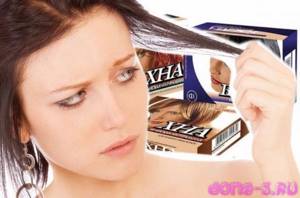
Like any other product, henna has a number of significant disadvantages. We have listed them below:
- There is no point in covering gray hair with henna; it leaves gray hair almost unchanged.
- Henna should not be used by those with dry hair. Tannins help normalize the secretion of sebum by the dermis of the head, but with dry strands this property makes the curls brittle and lifeless.
- With frequent use, henna destroys the natural protective barrier of the hair, causing curls to become unruly and stiff, lose elasticity and acquire a dull hue.
- Henna can straighten strands from the first use, so there is no point in using this product for girls who want curly hair.
- Henna cannot be used in combination with other types of dyes or applied to already colored strands. Hair color may change completely differently than you imagined. The same rule applies when dyeing curls previously dyed with henna with store-bought dye. As a result, you will get an extraordinary appearance with green hair.
- Henna dyeing is an irreversible process, i.e. You won’t be able to fix and recolor your curls a new color. Because henna dyes penetrate into the hair and envelop it, there is simply no room left for new substances, and the color of the hair remains unchanged (this applies to natural dyes) or changes in a completely unpredictable way.
- Henna, like any other dye, fades greatly when dyed curls are exposed to sunlight.
Many women try to use henna as a natural coloring agent, because... its healing functions are many times greater than the benefits of store-bought chemical paints. Having learned the disadvantages of henna, you can decide on the type of hair coloring and decide which method suits you best.
Did you know that...
On average, about 20 hairs grow sequentially from one hair follicle over the course of a lifetime.
Show another fact
Is it possible for pregnant and lactating women to dye their hair with henna?
Another significant difference between henna for hair and other dyes lies in the fact that it is absolutely safe for nursing mothers and pregnant women. Henna, like basma, is a natural plant pigment, the benefits and lack of toxic odor of which allow it to be used during pregnancy and breastfeeding without fear of harming yourself or your child.
We recommend reading: Botox or hyaluronic acid: which is better, how to make the right choice
However, it should be taken into account that due to hormonal fluctuations in the first trimester of pregnancy, hair coloring with henna and basma can lead to unexpected results in terms of color, which is often far from the desired one. Therefore, a reasonable decision would be not to carry out the coloring procedure during the first 11 to 12 weeks.
Positive effects of henna on hair
Henna is a natural dye, so it has quite a lot of useful qualities. We will consider each advantage of the described tool in more detail:
- Henna is a natural dye, so allergies to it occur in a small number of people who suffer from individual intolerance to various elements in the composition of the product.
- Penetrating into the structure of the hair, henna fills the gaps in it, making the hair smooth and dense.
- Henna weighs down curls, helping to straighten them and treat split ends.
- The natural components that make up henna strengthen the hair follicles and make the hair strong and strong.
- Henna changes the color of the strands and keeps their structure unchanged (and even improved).
- The antiseptic components of henna help get rid of dandruff and prevent its occurrence.
- Henna makes hair smooth and shiny.
- Henna heals the epidermis of the head and helps it regulate sebum production.
- When used correctly, henna helps eliminate brittleness in strands and restore vital energy to them.
- Henna dyeing helps make your hair color bright and rich.
- You can use henna at any age.
- Thanks to its natural composition, henna can be used even during pregnancy and breastfeeding.
How to prepare henna correctly
However, in order to get the maximum benefit from vegetable hair dye and get a bright shade, you need to be able to properly prepare the mixture for coloring:
- It is necessary to strictly follow the instructions on the henna packaging, since the slightest deviation from the instructions can have a significant impact on the result.
- Lawsonia powder should not be diluted in boiling water, since too high a temperature will negate all the beneficial properties. The ideal water temperature should be 70 oC.
- It is advisable to dilute the henna dye composition in a ceramic, clay or glass vessel. Any other utensils that come into contact with the dye trigger an oxidative process, the harm of which can affect the final shade of the hair.
- Since paint tends to deteriorate quickly in an open package, if possible, you should use the entire available portion of the powder.
Advice! To better consolidate the effect on your hair, you can add kefir, natural wine or lemon juice to the henna solution.
Recommendations for use
If you decide to dye your hair with henna, it will be useful for you to learn about its little secrets so that the dyeing result brings maximum benefits. The rules are very simple:
- Strand test. If you doubt the result, do not rush to dye your entire hair. Getting rid of the persistent effect of henna is not as easy as we would like. Test the dye on a small strand of your hair, and at the same time decide on the exact dyeing time to get the desired shade;
- Follow all instructions in the instructions! As a rule, any henna, both Indian and Iranian, is diluted with water at a temperature of 70 degrees. Henna for hair can be diluted with boiling water, and it will not cease to be a dye, but will completely lose its beneficial properties. Everything that is mentioned on the label is very important;
- Moisturize your hair. Henna has a drying effect, and if you use it more than once every 2 months, regularly make moisturizing hair masks.
What determines hair color after henna dyeing?
Henna powder, due to its beneficial properties, has a fairly wide range of different shades. This variation is primarily due to the natural color of the hair that will be dyed. Thus, light-colored curls will acquire a bright red color with a golden tint, while light brown and dark ones will become the same color as copper or become a mahogany shade. But this is provided that they have not previously been in contact with chemical paint, otherwise the reflection in the mirror will subsequently surprise you with bright blue or green strands. But basma gives hair a deep chocolate or black color, depending on the amount of the substance.
In addition, you can somewhat diversify the above palette by combining henna and basma with each other or mixing them with other natural pigments. This will enrich the coloring mixture with additional beneficial compounds:
- Lawsonia powder and coffee will give the curls a dark red or chestnut tone;
- together with beet juice it will give an eggplant or purple tint;
- plant pigment drenched in milk will make the red color many times darker;
- Basma in combination with red henna will help achieve a shade of fresh cinnamon.
How to make henna as beneficial as possible?
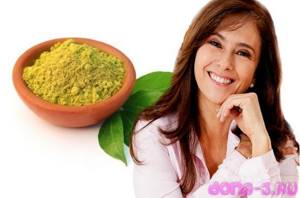
You can protect your hair from the possible negative consequences of henna dyeing and reduce its negative impact on your curls using the following tips:
- Before applying the entire composition to your curls, check the dyeing result on an inconspicuous thin strand: if you like the new shade, then use henna for your entire hair.
- Henna dyeing should be done no more than once a month.
- Be sure to follow the directions and dosages given in the instructions for the product. Any arbitrariness can make the color of your curls far from the expected result.
- Under no circumstances should you mix henna powder with chemical dye. The result of such actions can be very disastrous.
- Try not to use colorless henna too often - once a week will be enough to care for your curls.
- To prepare henna, try to use water with a temperature no higher than 70 degrees. Boiling water cancels the beneficial properties of the product and makes it useless for curls.
Using henna as a dye is more labor-intensive and messy than dyeing hair with store-bought dye. Try to protect your skin and clothing from the product's dyes by wearing rubber gloves, cellophane neck guards, and unnecessary clothing. Be sure to follow the recommendations described in the instructions - this is the only way you can ensure the desired result and a safe outcome of the entire procedure.
By using henna correctly and following the above rules and tips, you can achieve the most beneficial results and make your curls healthier and more attractive without much effort and incredible costs.
How to apply henna to hair
Paint application also has its own nuances. To avoid harm from unexpected reactions during the procedure, you should prepare for it in advance:
- It is advisable to dye on pre-washed dry strands. You should dry your curls naturally without using a hairdryer.
- Before painting, it would be a good idea to cover your shoulders and neck with an oilcloth cape.
- The area around the forehead and ears should be generously lubricated with a rich cream so that at the end of the procedure no traces of dye remain on them.
- You need to wear rubber gloves when painting, as the substance tends to be absorbed into the skin for a long time.
The coloring itself is carried out according to the following scheme:
- The dye is applied to the roots, moving from the back of the head to the forehead.
- Then the mixture is evenly distributed over the entire length, being careful not to hesitate so that the product does not cool down too much.
- After this, the head is wrapped in polyethylene. For these purposes, you can use a plastic bag.
- From above, the head is insulated with a soft piece of fabric, for example, an old towel.
Advice! Before applying the mixture all over your hair, it is safe to test it on a thin strand. So, in case of an unsatisfactory shade, it is easier to adjust the composition.
How often can you use henna
Ardent opponents of various chemical dyes simply cannot imagine their life without henna. This natural dye can do a lot for hair:
- paint;
- strengthen;
- remove dandruff;
- improve the growth of strands.
But is it possible to use it often and dye your hair with henna? It is believed that this natural remedy has a cumulative effect and is practically not washed off. You only need to periodically maintain the color and refresh it. With each new paint job, this shade will become richer and more beautiful.
However, do not forget that any remedy is good in moderation and should not be used too often.
Henna should not be used after highlighting or perming.
It is recommended to use henna no more than once every two months, since the risk of drying out the strands is very high, so if you dye your hair more often, it will become dull. There is an opinion that it can clog the hair follicles, which is why they lose their elasticity and the strands become stiffer. You can tint the roots a little more often.
It is quite easy to use at home. All you need to do is dilute the henna bag with warm water and stir until it reaches the consistency of sour cream. Before doing this, you need to wash and dry your hair well. This product must be applied from the back of the head, and then distributed over the entire length. It should remain on the strands from 30 minutes to an hour and a half.
It is best to use henna with another natural dye - basma and dye your hair with this composition. With this combination it is possible to achieve shades of curls from dark chestnut to black.
Hair becomes shiny and beautiful, but if you use henna wisely and not too often.
How long to keep henna
The optimal lifespan of the dye depends on many factors, including the initial tone of the curls, their length, skin type, type of dye, its properties and quantity. The most accurate time indicators, as a rule, are displayed in the instructions, which you should focus on first. After all, if you leave the composition on your hair for too long, you can cause significant harm to it. If you wash off the dye ahead of time, you can completely reduce the entire effect of the procedure to zero.
The average exposure time for natural blondes is only 10 - 15 minutes. For owners of light brown braids, 30 - 60 minutes will be enough; brown-haired women will have to wait from 2 to 3 hours, depending on the length.
Pros of henna
- Helps get rid of dandruff due to its antiseptic properties .
- It has a very good effect on oily scalp, thanks to the tannins in the composition. You can simply make masks from colorless henna, if you don’t want to dye them with regular henna.
- Henna dyeing does not change the hair structure.
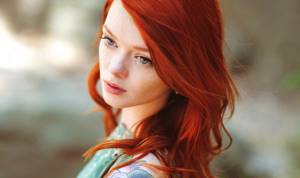
- Because henna literally envelops every hair, they become thicker, and the hair will appear thicker. Because of this, the hair will be more shiny and smooth from the very first use.
- Hair becomes more elastic and dense, which makes styling much easier.
- Henna dyeing gives hair a very long-lasting and rich color.
- If the hair is thin and light, it will color very quickly (in 10-15 minutes there will already be a pleasant reddish tint).
- Accelerates hair growth.
- Strengthens hair.
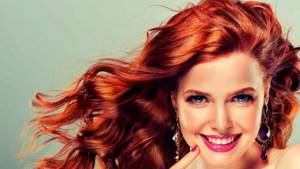
- The completely natural origin of henna allows it to be used by pregnant and lactating women.
- Few people are allergic to henna.
- Henna dyeing has no return restrictions.
- Henna powder price . In general, the price range is huge: from 15 to several hundred rubles, depending on the type of henna itself and the manufacturer.
- Does not stain dishes or the bathtub if you wash them immediately.
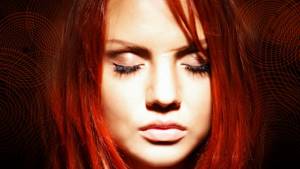
How to properly remove henna from hair
Lawsonia powder is distinguished by its durability, and therefore it can be difficult to wash it off after dyeing is completed. This stage of the procedure has its own characteristics:
- To get rid of paint, the curls are washed with running water until the liquid becomes completely transparent. For efficiency, the curls are divided into strands and washed one at a time.
- When rinsing, do not use shampoo or soap.
- If desired, conditioner is applied to the strands.
- For the next three days, do not wash your hair to allow the color to set.
We recommend reading: What are the benefits of Achatina snails, properties, photos and reviews
Features of hair coloring with henna and basma
A few useful tips will help you dye your hair without problems and get the desired hair color:
- You should be careful when applying Lawsonia powder to gray hair. At best, the paint will not be able to adhere, and at worst, it will make the curls the color of a ripe tangerine.
- Henna and basma in their pure form are excellent for normal and oily hair types, while it is not advisable to treat dry curls with them. To mitigate the impact, it is worth combining dyes with any vegetable oil - there will be less harm from the pigments, and the beneficial substances of the oils will enrich the strands with minerals and vitamins.
- There is no need to worry if immediately after painting the color becomes overly saturated. After a few days the shade will become more natural.
Frequency of use
Henna and basma are used to obtain bright hair color. Cosmetics based on them can not only change color, but also eliminate dandruff, improve the growth of curls, and strengthen them.
The henna-based coloring mixture has a cumulative effect, since it is almost not washed off. You just need to update the color frequently. Each coloring with henna and basma will make your hair richer. You can use these components in moderation, and not too often. This also applies to other coloring agents.
The use of henna and basma is contraindicated after perm or highlighting. You need to use such dyes once every 2 months, since there is a possibility of drying out the strands. If you often dye your hair, you can make it dull. After the main coloring, you can renew the roots more often.
Harm of henna to hair and contraindications for use
The uniqueness of lavsonia powder, in addition to a large number of useful properties, lies in the almost complete absence of any harmful effects on humans. It does not cause allergic reactions or other discomfort, which is why almost everyone can use it. The only medical contraindication is glucose-6-phosphate dehydrogenase deficiency, a rare inborn error of metabolism, common mainly in Africa, Asia and the Middle East.
However, with all its advantages, henna also has some disadvantages, which, although purely cosmetic in nature, can have a significant impact on the appearance of the strands. So, it is not recommended for already colored curls, as it can change the original shade beyond recognition. The same applies to the opposite situation: hair that has been exposed to lavsonia powder cannot be dyed with chemicals, otherwise you may end up with not very attractive green hair. Then it will not be possible to correct the consequences of unsuccessful henna dyeing using paints from well-known brands. In this case, you will have to wait until the strands grow completely.
In addition, the powder is absolutely incompatible with perm, as it has the property of straightening artificially curled curls.
Another property of the powder that is difficult to wash off the skin does not so much harm as inconvenience. Therefore, during the dyeing process, you need to be twice as careful not to stain your face and hands.
And although short-term use of tinted henna only benefits hair, long-term use can cause significant harm. Thus, abuse of the dye violates the integrity of the protective layer of the strands, which is why they become stiff, dull, split, and have lost their elasticity. For this reason, before use, you should carefully read the instructions and strictly follow them.
How to reduce the harmful effects of henna on hair
You can significantly reduce the harmful effects of paint if you follow simple recommendations.
- Lawsonia powder should not be used more than once every 3 to 4 weeks.
- It is strictly not recommended to mix chemical dye with natural dye.
- For maximum benefit when dyeing your hair with henna, you must follow the instructions.
- Masks made from colorless henna should not be made too often. To avoid harmful effects, it is enough to carry out the procedure once a week.
Henna for hair: benefits and harm. What do you need to know?
Natural hair cosmetics are gaining more and more popularity among girls of all ages every year. One of the most popular remedies is henna. However, as many people as there are, so many opinions, and this coloring agent was no exception. Henna for hair benefits and harms is something that interests many young ladies who are just about to use the product and experience its positive qualities for themselves.
We recommend reading: Brown hair dye, review and reviews
Henna for hair and its qualities
This substance has a large number of positive qualities that have been known for a long time. Henna for hair, the benefits it has, is a large list of positive qualities, namely:
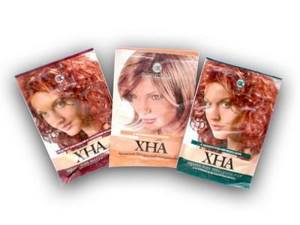
- Significantly reduces the level of hair fragility.
- Each hair acquires additional density.
- There are no age restrictions on the use of this product.
- There are no contraindications. Even pregnant and lactating women can use it to color their hair;
- It is useful for regulating the activity of the glands that produce sebum. Significantly improves the condition of the scalp.
- No allergic reactions. This is a big plus for allergy sufferers, since sometimes it is quite difficult to choose the right product with a chemical composition that would also be gentle on the hair.
- Hair becomes softer, smoother and shiny.
- By smoothing the hair cuticle, it restores hair. Prevents split ends.
- Has a powerful strengthening effect on the hair follicle;
- The colors obtained through dyeing become richer and more durable.
- The structure of the hair does not change, the strands are colored evenly.
- Cures dandruff thanks to its natural antiseptic properties.

Surely, there will be those who doubt some or even all of the positive qualities, however, you just have to look at the charming hairstyles of beauties from the east... Thick braids, obedient hair. The use of henna gave them such a luxurious look and well-groomed hair.
You should know that...
It is worth mentioning the disadvantages that, unfortunately, this type of staining is not without:
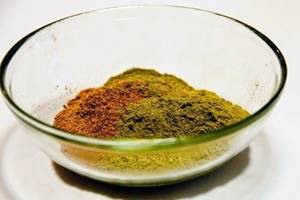
- There is no possibility of correcting poor-quality henna dyeing using chemical dyes.
- The substance fades when exposed to sunlight. This applies to all dyes.
- If you use henna quite often, problems may soon arise. This will result in dull, split ends that will be difficult to get rid of. The hair will no longer be elastic, vibrant, and will become much more unruly and coarse.
- Just as in the previous case, frequent use will significantly dry out the curls and skin epidermis. The skin will begin to lose moisture due to tannins, which have a positive effect on oily hair types, but are more detrimental to dry hair. This leads to brittleness and loss.
- The perm will not last long if you use henna on it. Curls will turn into straight curls.
- Completely incompatible with “classic” coloring compounds. If you want to try its effect on colored hair, the color can exceed all expectations and become incredibly surprisingly unpleasant. The same applies to the procedure for dyeing hair previously dyed with henna of a different color. The hair will take on a greenish tint.
- Henna is not the best fighter against gray hair. It affects it differently: it can color them barely noticeably, like a tinting agent, or, on the contrary, it can significantly color the hairs brighter than healthy ones.
Read: Biohair curling. Reviews of biochemical perm, photos and price of the procedure
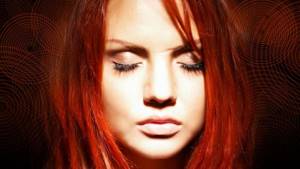
We recommend reading: Which red hair dye to choose
Means to reduce harmful effects
Now both sides have become clear, however, the question remains open - is it possible to reduce the harm caused? Yes, you can, and here are the rules you need to follow:
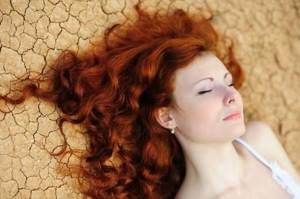
- Before dyeing your hair with henna, you should do a small test by applying the substance to a thin strand.
- In order not to waste all the beneficial properties of the substance, you should not use boiling water, but rather hot water. The liquid should not exceed 70 degrees . It is this temperature regime that will ensure the correct effect of the components on the hair.
- You should not ignore the instructions , as some manufacturers indicate the sequence and other data differently.
- It is strictly forbidden to experiment by combining synthetic components of other dyes with henna. This can have an extremely detrimental effect on the overall appearance and health of the hair.
- You should not use a product such as colorless henna for hair, the benefits and harms of which will be described a little below, too often . Masks based on it can also damage strands, dry out and make hair brittle.
- Dyeing is not carried out more often than once every 30 days , otherwise the hair will absorb the components deeply into itself, compromising the overall integrity of the hair.
We recommend reading: Color palette and reviews of Estelle paint
Colorless henna for hair
When talking about this product, you should immediately pay attention to the fact that it is not used as a coloring agent. This type, created from plant stems, helps provide proper hair care, giving it strength, shine and health. There are no contraindications or precautions as such. However, to make sure of this, it is better to test the product on a strand of hair in advance in order to know for sure that there is no personal immunity to the components of the composition or an existing allergy.
Read: Perm for short hair, photos and features of the procedure
This is a useful composition that transforms a woman's hairstyle, giving volume and beauty that many people dream of. For greater effect, it is added to masks, for which strictly natural ingredients are used. Colorless henna, like all its other types, cannot “get along” with chemicals of any kind, therefore, it is strongly recommended not to mix it with conventional dye compositions. If the hair has been subjected to classical dyeing, then henna is applied no earlier than after 2-3 weeks, so that a negative reaction from the components does not occur.
How to choose henna for hair
Choosing a dye is not an easy task. To reduce possible harm to zero and extract only benefits from the product, it is recommended:
- Monitor the expiration date of the product.
- Give preference to dyes made from natural ingredients without artificial additives.
- Choose paint in undamaged packaging.
- Decide in advance for what purpose the product will be used. For coloring, you should opt for basma and red henna, but for masks and health products, colorless henna is better suited.
- Pay attention to the country of origin. Iranian, Turkish and Indian henna is considered to be of the highest quality and natural.
